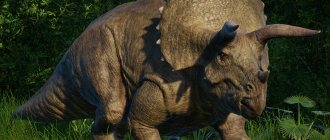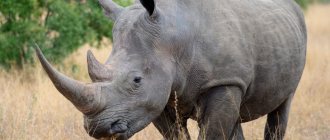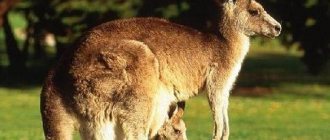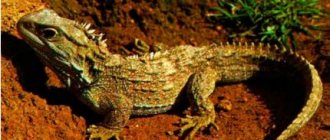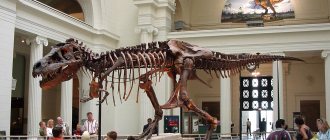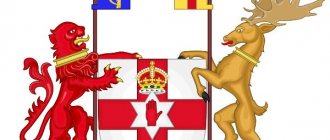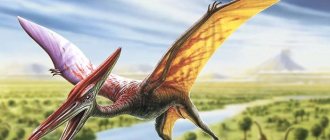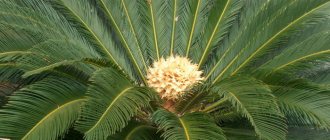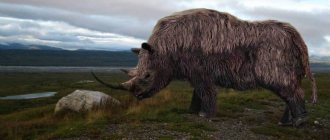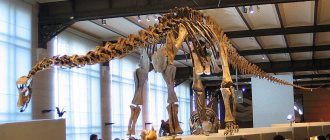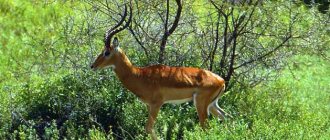In the second half of the Cretaceous period, extensive thickets of grass first appeared on our planet. Once on these chalk meadows and steppes, we would see animals grazing among the tall grass, which from a distance resemble elephants or rhinoceroses. But in fact, these are not mammals, but dinosaurs called Triceratops. They got their name from their three sharp horns; translated from Greek it means “three-horned face.”
Scientists have found many fossilized remains of Triceratops. Using them, paleontologists studied in detail how these ancient lizards lived.
A third of the body's length was in the skull
A Triceratops skeleton is on display at the Carnegie Museum of Natural History in Pittsburgh, Pennsylvania.
One of the characteristic features that makes Triceratops so recognizable is its huge skull, which, including the collar, could exceed 2 meters in length. The skulls of other ceratopsians, such as Centrosaurus and Styracosaurus, were even larger and had a more complex structure. Such a complex and diverse structure of skulls in ceratopsians probably arose as a result of sexual selection. Females may have preferred males with more massive and well-armed heads; such males seemed the strongest or occupied a dominant position in the herd. Among ceratopsians, Titanoceratops had the largest skull.
Pentaceratops
Pentaceratops is often said to have the largest skull of any land animal (only Torosaurus and Eotriceratops can rival it). Its name means "five". This lizard had its two horns, which are epijugal bones (like spines under the eyes) that most Ceretopsians had. They were the largest especially in Pentaceratops. Another interesting feature of Pentaceratops is its frill, which is slightly different from the frills of other ceratopsians. It is vertical and heart-shaped in shape. The frill had two holes or "fenestrae" which were covered with leather. Paleontologists believe this skin was brightly colored and used to frighten predators and challenge rivals of its own species. It's even possible that Pentaceratops could change skin colors and patterns like a chameleon, although this has not been proven. The remains of Pentaceratops were discovered in New Mexico - it was a very large beast, more than 8 meters long and weighing up to 5.5 tons.
Had a beak like a bird's
Triceratops beak.
Triceratops had a beak similar to those of birds and turtles. With its help, they could pick and eat tough plant foods (cycads, ginkgo and pine needles). The chewing teeth of Triceratops were grouped into “batteries.” Since the teeth were constantly worn out from chewing hard food, throughout the life of the dinosaur, they were replaced with new “batteries” of teeth.
Einiosaurus
Einiosaurus was discovered in 1985 and classified in 1995. Its name means "buffalo lizard". Although it was closely related to Styracosaurus, it had a very different appearance - it had only two long, straight horns on its frill and a strange, flattened, forward-curved nasal horn, similar to a bottle opener. Although the nasal horn was probably not a very effective weapon, the straight, frilled horns likely protected the animal from the bites of large carnivorous dinosaurs by preventing them from biting directly on the neck. Like Pachyrhinosaurus, Einiosaurus has been shown to live in large herds. His remains were found in Montana.
Triceratops' ancestors were the size of a cat
Chaoyangosaurus.
Ancestor of Triceratops By the time ceratopsians reached North America, they had reached the size of cattle at the end of the Cretaceous. While their distant ancestors were small, sometimes bipedal, herbivorous dinosaurs that lived in Central and East Asia. One of the earliest ceratopsians was Chaoyangsaurus, which weighed approximately 13 kg and had only a hint of horns and a collar. Other early members of the family may have been even smaller.
It's safer in a group
Paleontologists believe that horned Triceratops lived in entire herds. This helped them defend against large dinosaurs, such as tyrannosaurs. When an enemy appeared, adult Triceratops stood in a circle and covered their weaker brothers with themselves, putting their sharp horns forward. Modern African bison use this tactic.
The collar may have been used to signal other members of the herd
As is often the case in the animal world, organs perform several functions at once. The Triceratops collar was a thin flap of skin stretched over bone. It could have several functions. Most likely, the collar was used to signal other members of the herd. For example, when reddened by the abundant blood flow, the collar could signal sexual availability or warn of danger. It could also be involved in the process of regulating the body temperature of Triceratops.
Stegosaurus
Stegosaurus is a Late Jurassic dinosaur that existed 155–145 million years ago. It is easily recognized among other species by its dorsal plates. It is noteworthy that 70 million years separate stegosaurs and tyrannosaurs, just as 70 million separates humans from tyrannosaurs.
Stegosaurus: Pxhere
Stegosaurs were discovered in 1877 by professor of paleontology Othniel Marsh. The height of the dinosaurs reached 3-4 m, length - 9 m. Weight was about 2-3 tons. The huge body was controlled by a brain that weighed only 70 g and was smaller than a dog's. There is a version that stegosaurs had a “hind” brain, which helped defend against predators attacking from behind.
The animal ate plants. Stegosaurs probably swallowed stones, which helped them grind and digest food. There were spikes on the animal's tail, and there were 17 large plates on its back.
Perhaps Torosaurus and Triceratops are the same dinosaur
The horned Torosaurus was similar to male Triceratops.
As paleontological data accumulate, some species of dinosaurs are beginning to be viewed not as separate species, but as juvenile forms of others. It is likely that the two-horned Torosaurus represents a very old male Triceratops, whose collar continued to grow throughout its life. Most likely, Torosaurus will be attributed to Triceratops, and not vice versa.
Diabloceratops
Diabloceratops
Diabloceratops means "devil horned face". His impressive remains were found in Utah. This dinosaur had two small horns just above its eyes, and the two horns that grew from the top of the frill were quite large. These four horns, together with the lateral sinuous frill, gave this animal a strange appearance, distinguishing it from all known horned dinosaurs. Diabloceratops is classified as a primitive horned dinosaur as it shares some anatomical features with Protoceratops. Its jaws were massive, indicating that its grip was very strong. The same can be said of most other ceratopsians, and it is possible that many of their species used their huge beaks as well as horns as weapons against predators.
Bone Wars
In 1887, American paleontologist Othniel Marsh examined a partially preserved Triceratops skull with horns and erroneously described the remains as belonging to the giant bison Bison alticornis. Marsh quickly corrected this error, although in the so-called Bone Wars between paleontologists Marsh and Cope, both of them made a large number of similar errors.
Pterodactyl
Pterodactyls are a genus of flying dinosaurs that belong to the pterosaurs. Pterodactyls lived 152–145 million years ago.
Dinosaurs had wings made of a skin-muscle membrane, which was attached to an elongated fourth digit. The membrane was supported by collagen fibers and keratin ridges.
Pterodactyl: Pixabay
Pterodactyls are the first flying reptiles discovered by humans. They became one of the first dinosaurs discovered by humans: the first example of a pterodactyl was described in 1784 in Germany.
Pterodactyls were carnivores and hunted fish and small animals. Scientists suggest that they led a diurnal lifestyle and organically shared their ecological niche with other flying dinosaurs that hunted at night (rhamphorhynchus, ctenochasma).
Triceratops fossils are highly prized by collectors
Due to their size and characteristic structure, Triceratops skulls are highly prized by museums and private collectors. In 2008, a specimen called Triceratops Cliff was purchased by a private collector for $1 million and donated to the Boston Museum of Science. Unfortunately, the high demand for Triceratops bones has led to fraud and inflated prices for fossils.
Tyrannosaurus
Tyrannosaurus is a genus of predatory carnivorous dinosaurs, which is represented by a single species - Tyrannosaurus rex. The ancient animal lived on the island of Laramidia, which later became the western part of North America. The discovered dinosaur remains date back to 70–66 million years ago.
He was a two-legged dinosaur. Compared with most other bipeds, its forelimbs were much better developed and had claws, although they were significantly inferior to the huge hind legs.
Tyrannosaurus: Facebook/World Wide Wyatt
Tyrannosaurs are the largest predators in Earth's history. Their height reached 12–13 m, and their weight was about 9 tons. It is assumed that Tyrannosaurus was at the top of the food chain and had no natural competitors. Some researchers classify tyrannosaurs as opportunistic predators who did not refuse carrion if it was available.
To date, about 50 skeletons have been found. In culture, Tyrannosaurus is one of the most famous dinosaurs about which films are made. He gained popularity thanks to Steven Spielberg's film Jurassic Park (1993).
Brontosaurus
Brontosaurus is a genus of giant dinosaurs from the sauropod family. It is distinguished by its large size and long neck. The animal reached 21 m in length and weighed about 15 tons. Brontosaurs lived on Earth about 156–146 million years ago during the Late Jurassic period.
Analysis of dinosaur tracks showed that brontosaurs, despite their gigantic size, developed a speed of 20–30 km/h and covered up to 40 km per day. Brontosaurs were completely terrestrial animals, although with their mass it would have been more comfortable to lead a semi-aquatic lifestyle.
Brontosaurus: Pxhere
Brontosaurus is one of the most common images in art. It appeared in the films The Lost World (1925), King Kong (1933), and was used as logos and images on postage stamps. Although the most common image of a brontosaurus in art is a dinosaur with a long neck raised high. It is believed that brontosaurs held it upright most of the time.
